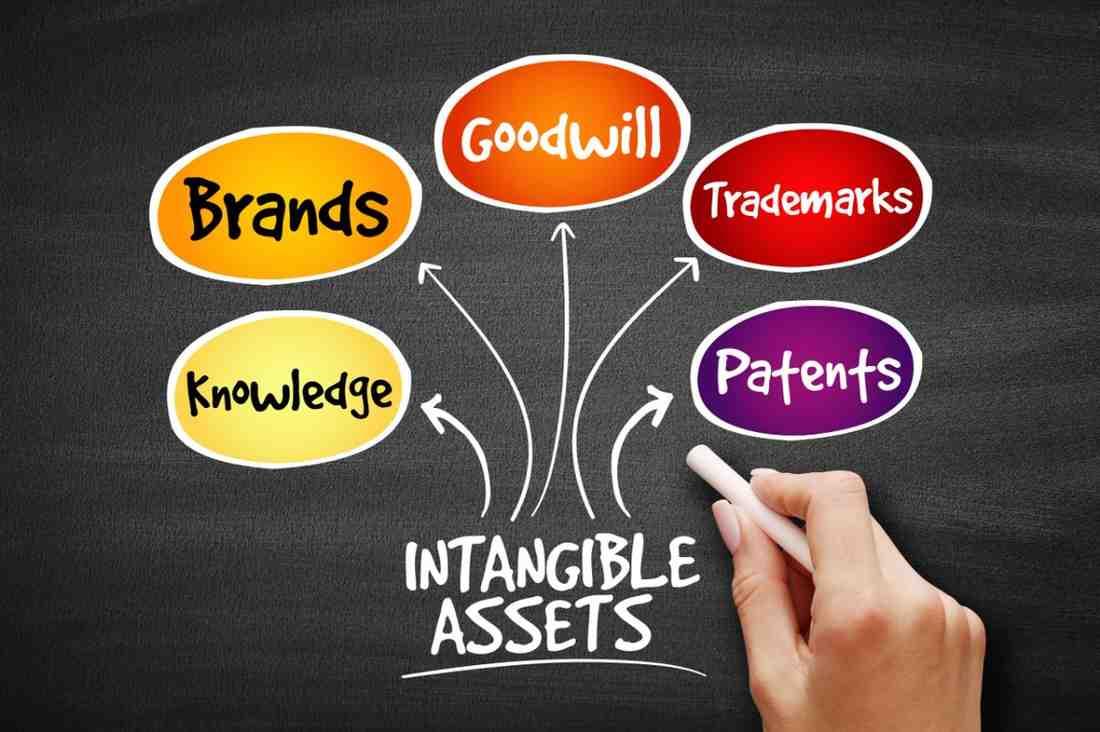Intangible assets are non-physical assets that have value because of their intellectual or legal properties. Unlike tangible assets such as machinery or real estate.

What Are Intangible Assets?
Intangible assets are non-physical assets that have value because of their intellectual or legal properties. Unlike tangible assets such as machinery or real estate, intangible assets are not visible but are crucial to a company's long-term success. They represent legal rights, competitive advantages, or other beneficial attributes that contribute to a company's profitability and market position.
Examples of Intangible Assets:
• Patents: Legal rights granted for inventions or processes.
• Trademarks: Symbols, names, or logos that distinguish products or services.
• Copyrights: Protection for original works of authorship such as books, music, and software.
• Goodwill: The worth of a company's reputation, customers, and brand.
• Trade Secrets: Confidential business information that provides a competitive edge.
• Brand Recognition: The value of a brand’s reputation and customer perception.
• Software: Developed or acquired software used in business operations.
Types of Intangible Assets
Patents
Patents provide exclusive rights to inventions and innovations for a specified period, usually 20 years. They shield a company's innovative products and processes from imitation by rivals.
Trademarks
Trademarks are symbols, names, or logos that identify and distinguish products or services from others. They help build brand recognition and customer loyalty.
Copyrights
Copyrights protect original works such as literary, musical, and artistic creations. They provide the creator with exclusive permission to reproduce, circulate, and showcase their work.
Goodwill
Goodwill represents the premium a company pays over the fair value of its net assets when acquiring another business. It includes factors like customer relationships, brand reputation, and employee expertise.
Trade Secrets
Trade secrets encompass confidential business knowledge that helps a company outperform rivals. Examples include proprietary formulas, business strategies, and customer lists.
Brand Recognition
Brand recognition is the value associated with a company’s brand, reflecting customer trust and loyalty. A strong brand can drive sales and enhance market position.
Software
Software developed or acquired by a company is considered an intangible asset if it is used in business operations. This encompasses both custom-built and commercially available software that significantly contributes to a company's bottom line.
Valuation of Intangible Assets
The intangible nature of these assets makes valuation a complex task. However, accurate valuation is crucial for financial reporting, mergers and acquisitions, and investment decisions. Common approaches to valuing intangible assets encompass...
Cost Approach
This method calculates the value based on the cost to recreate or replace the asset. It considers factors like development costs and adjustments for obsolescence.
Market Approach
The market approach determines the value of intangible assets by benchmarking them against similar assets that have been recently sold. It uses data from similar assets to estimate the fair market value.
Income Approach
This approach estimates the value based on the future economic benefits the asset is expected to generate. It involves forecasting cash flows and discounting them to present value.
Relief-from-Royalty Method
This method calculates the asset's value by determining the potential savings from owning it outright instead of paying ongoing licensing fees.
Challenges in Valuation:
• The intangible nature of these assets makes it challenging to use traditional valuation techniques.
• The future economic benefits of intangible assets are often uncertain and difficult to predict.
• The valuation process requires extensive data and expertise to ensure accuracy.
Intangible Assets on Financial Statements
Intangible assets are reported on the balance sheet under non-current assets. They are usually classified into two categories:
Identifiable Intangible Assets
These assets can be separated from the company and sold or licensed. Examples include patents, trademarks, and copyrights.
Unidentifiable Intangible Assets
These assets cannot be separated from the company and include goodwill and brand recognition.
Accounting Treatment:
• Initial Recognition: The initial recognition of intangible assets is at their purchase price.If purchased, they are recognized at the purchase price. If internally developed, costs are capitalized if they meet specific criteria.
• Amortization: Intangible assets with finite useful lives are amortized over their estimated life. The amortization expense is listed on the income statement.
• Impairment: If the carrying amount of an intangible asset exceeds its recoverable amount, an impairment loss is recognized. This ensures the asset is reported at its fair value.
Management and Amortization of Intangible Assets
Effective management of intangible assets involves monitoring their value, ensuring they are properly accounted for, and maximizing their potential benefits.
Strategies for Managing Intangible Assets:
• Regular Valuation: Periodically assess the value of intangible assets to ensure accurate financial reporting.
• Protection Measures: Implement legal protections such as trademarks, copyrights, and patents to safeguard intangible assets.
• Utilization: Develop strategies to leverage intangible assets for competitive advantage and growth.
Amortization vs. Depreciation:
• Amortization: Applied to intangible assets, amortization spreads the cost of the asset over its useful life. Amortization is the process of allocating the cost of an intangible asset over its useful life, akin to depreciation for physical assets.
• Depreciation: Applied to tangible assets, depreciation allocates the cost of physical assets over their useful life.
Impact on Financial Statements:
Amortization expenses reduce taxable income and can affect profitability. Accurate reporting is essential for financial transparency and investor confidence.
Tax Treatment and Financial Reporting
Intangible assets have specific tax implications and reporting requirements. Understanding these can help businesses optimize their tax strategies and ensure compliance.
Tax Considerations:
• Amortization Deductions: Businesses can often deduct amortization expenses for tax purposes. Amortization lowers taxable income, resulting in reduced tax payments.
• Capitalization vs. Expensing: Costs related to acquiring or developing intangible assets are typically capitalized and amortized over time rather than expensed immediately.
Financial Reporting:
• Disclosure: Companies must disclose information about intangible assets in their financial statements, including their nature, carrying amounts, and amortization policies.
• Compliance: Adhering to accounting standards and regulations ensures accurate and transparent financial reporting.
Conclusion
Intangible assets are essential drivers of a company's growth and profitability.Understanding their types, valuation methods, and management strategies is crucial for effective financial planning and decision-making. By recognizing the importance of intangible assets and implementing proper accounting and management practices, businesses can enhance their financial stability and competitive edge.
FAQs
What are the main types of intangible assets?
Intangible assets include patents, trademarks, copyrights, goodwill, trade secrets, brand recognition, and software.
How do you value intangible assets?
Intangible assets can be valued using methods such as the cost approach, market approach, income approach, and relief-from-royalty method.
What is the difference between amortization and depreciation of intangible assets?
Amortization applies to intangible assets and spreads their cost over their useful life, while depreciation applies to tangible assets and allocates their cost over time.
How are intangible assets reported on financial statements?
Intangible assets are categorized as identifiable or unidentifiable and listed under non-current assets in a company's financial statements.
Why are intangible assets important for businesses?
Intangible assets contribute to a company's value, competitive advantage, and market position. Intangible assets are essential for boosting a company's revenue and earnings.
What are some examples of intangible assets in real-world businesses?
Examples include a company's brand reputation, proprietary technology, exclusive trademarks, and customer loyalty programs.


































.png)
-min.png)
-min.png)
-min.png)
-min.png)







.png)









